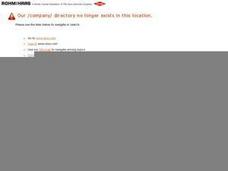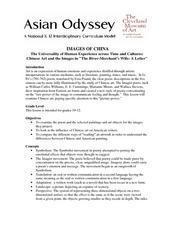Curated OER
Mixtures as Solutions or Colloids and the Tyndall Effect
Students classify mixtures as solution or colloids by virtue of the Tyndall Effect. They make a cone and tape to fit over the lens of the flashlight. They turn out the lights in the room and shine the flash light at each of the jars and...
Curated OER
The Perils of Drinking Water
Learners determine the presence of drugs in water. In this chemistry lesson, students experiment on water samples using thin layer and column chromatography. They determine the concentration of drugs present using graphical analysis.
Curated OER
Organs to Go...
Students explain the principles of experimental design and reinforce the steps of the scientific method. Each group of students create a "slush" type mixture to store a chicken liver.
Curated OER
Serial Dilution of CuSO4 and Changing the Value of Paint
Learners relate solution concentration and saturation to color and compare methods of changing value and color intensity with paint solutions.
Curated OER
Isolation of Synthetic Chemicals from Plant Leaves
Students isolate and identify a dye, which represents a synthetic pesticide, from plants.
Curated OER
Introduction to Gas Chromatography
Students analyze gas chromatograms and suggest various applications for gas chromatography.
Curated OER
Plant And Animal Cells
Students identify parts of plant and animal cells and describe the functions of each part. They distinguish between plant and animal cells. After a lecture/demo, students perform experiments which help them construct models of plant and...
Curated OER
Political Cartoons: Thinking Broadly, Communicating Succinctly
Students think broadly about the tsunami disaster and its aftermath through studying cartoons. Students critically think about the literary devices the authors/artists use, such as satire, metaphor and personification.
Curated OER
Mystery of the Eleven Unknown Substances
Fourth graders identify eleven white substances that are commonly found in the household. They, in pairs, perform experiments on a variety of substances, and must identify them based on the reactions they observe.
Curated OER
Teaching about Conductivity
High schoolers explore conductivity and productivity in aquatic systems.
Curated OER
Paste Papers
Students combine acrylics with School Smart Art Paste to paint paper and to explore color mixing.
Curated OER
Sea Floor Spreading
Pupils recreate sea-floor spreading and the pattern of magnetic stripes that are created by different configurations of plate boundaries. They see how transform faults work.
Curated OER
Mold It
Pupils make molds of various items of their choosing using the Molt-It kit. They discuss the scientific value of making molds.
Curated OER
Testing Growth of Algae
Students participate in an experiment in which they test the growing rate of algae. They test the algae in different elements recording their observations. They share their results with the class and discuss.
Curated OER
What Effects Do Trees Have On The Environment?
Students examine the interrelationship between trees, soil and people focusing on urban areas. They collect and analyze data about trees in their research area.
Curated OER
How Soft or Hard is Your Water?
Learners test samples of water to determine how a chemical water softener affects water's ability to form suds. After collecting their data and analyzing their results, students answer follow-up questions about their lab.
Curated OER
How Can We Observe Genetic Variation Within a Species?
Young scholars observe intra-species variation by completing standard microbial streaking procedures. They collect data from which they draw observations and complete a worksheet.
Curated OER
Extraction of DNA from White Onion
High schoolers investigate techniques involved in extracting and isolating DNA. Students extract and observe onion DNA.
Curated OER
How Can We Determine the Concentration of an Unknown Solution?
Students participate in experiments to help them determine the concentration of an unknown solution. They graph a standard curve and plotting the relationship between the concentration and the amount of light needed. They discuss their...
Curated OER
Mini-Molar Concentration of HCI
Students work together to create mini-molar concentrations of HCI. They record and analyze their data for specific results. They answer discussion questions to complete the lesson.
Curated OER
Water You Can Use from the Air Conditioner
Students work together to research water quantity, quality and safety standards. They complete a lab to discover how to use the water from an air conditioner. They write a paper to show their findings.
Curated OER
Images of China
Students examine the Chinese poem "The River-Merchant's Wife: A Letter" by Li Po while comparing the different ways of "reading" an artwork in order to understand the differences between Chinese and American painting.
Curated OER
Enzymatic Reaction
Young scholars explore the effect enzymes have on reactions. They demonstrate the process of enzymatic reaction by making cheese. after experimentation, they answer a series of questions.
Curated OER
Iron Filings
Students conduct an experiment in which a solution of copper(II) sulfate is added to iron filings. They write and balance the equation for the reaction that occurs and calculate the amount of iron that reacted and the percent yield of...
Other popular searches
- Fractional Distillation
- Water Distillation
- Distillation Lab
- Simple Distillation
- Distillation Crude Oil
- Fraction Distillation
- Salt Water Distillation
- Distillation Experiments
- Water Cycle and Distillation
- Fractional Distillation Labs
- Science Distillation
- Petroleum Distillation






